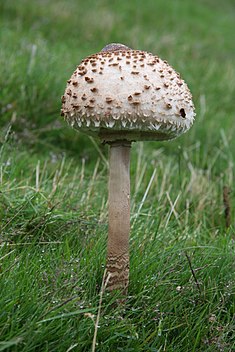Parasol mushroom
| Macrolepiota procera | |
|---|---|
 |
|
| A young parasol mushroom | |
| Scientific classification | |
| Kingdom: | Fungi |
| Division: | Basidiomycota |
| Class: | Agaricomycetes |
| Order: | Agaricales |
| Family: | Agaricaceae |
| Genus: | Macrolepiota |
| Species: | M. procera |
| Binomial name | |
|
Macrolepiota procera (Scop.) Singer (1948) |
|
| Synonyms | |
| Macrolepiota procera | |
|---|---|
| Mycological characteristics | |
| gills on hymenium | |
| cap is umbonate | |
| hymenium is free | |
| stipe has a ring | |
| spore print is white | |
| ecology is saprotrophic | |
| edibility: choice | |
The parasol mushroom (Macrolepiota procera or Lepiota procera) is a basidiomycete fungus with a large, prominent fruiting body resembling a parasol. It is a fairly common species on well-drained soils. It is found solitary or in groups and fairy rings in pastures and occasionally in woodland. Globally, it is widespread in temperate regions.
The fungus was first described in 1772 by Tyrolean naturalist Giovanni Antonio Scopoli, who named it Agaricus procerus.Rolf Singer transferred it to the genus Macrolepiota in 1948.
The height and cap diameter of a mature specimen may both reach 40 cm, a size truly impressive for the fruiting body of an agaric. The stipe is relatively thin and reaches full height before the cap has expanded. The stipe is very fibrous in texture which renders it inedible. The surface is characteristically wrapped in a snakeskin-like pattern of scaly growths (therefore, known in some parts of Europe as the "snake's hat" or "snake's sponge"). The immature cap is compact and egg-shaped, with the cap margin around the stipe, sealing a chamber inside the cap. As it matures, the margin breaks off, leaving a fleshy, movable ring around the stipe. At full maturity, the cap is more or less flat, with a chocolate-brown umbo in the centre that is leathery to touch. Dark and cap-coloured flakes remain on the upper surface of the cap and can be removed easily. The gills are crowded, free, and white with a pale pink tinge sometimes present. The spore print is white. It has a pleasant nutty smell. When sliced, the white flesh may turn a pale pink.
...
Wikipedia
